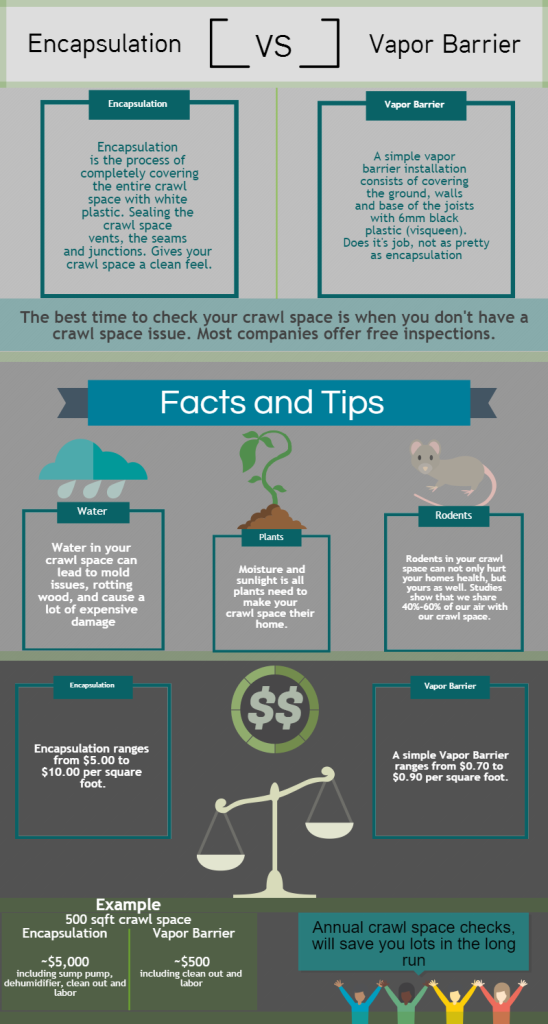Encapsulation Vs. Vapor Barrier
Portland OR, Vancouver WA
When it comes to your crawl space there always seems to be a lot of questions but no straight forward answers. On this page we will be talking about the differences between encapsulation and vapor barrier from a neutral perspective, so you can make the decision. Let’s begin, Encapsulation Vs. Vapor Barrier.
Encapsulation
Encapsulation is the process of completely sealing your entire crawl space in a white plastic. With encapsulation you are also required to install a sump pump, and dehumidifier. The purpose of encapsulation is to reduce the moisture in your crawl space, reducing your risk of mold. It also makes for cleaner air in your crawl space, which you share air with. After your crawl space in encapsulated, it makes for great storage area as well since it’s completely clean.
Facts
- When you encapsulate your crawl space, 100% of the ground is covered in a white plastic.
- All the seams, junctions and crawl space vents in your crawl space are totally sealed.
- Encapsulation usually comes with insulated foundation walls and band joist.
- With encapsulation you are required to have one of the three air conditioning methods: (i) dehumidifier (this is what is normally used) (ii) small amount of air supply from HVAC system, or (iii) small exhaust fan
Benefits
Having an encapsulated crawl space comes with many benefits, the greatest one (in our opinion) being, better air quality. Studies show that you share 40%-60% of the air you breathe, with your crawl space. So you want a clean crawl space. With encapsulating your crawl space you save money on your energy bill! The Advanced Energy studies have found nearly 20% reduction in energy use in homes with a conditioned crawl space. Having an encapsulated crawl space will reduce the humidity in your crawl space as well, decreasing your potential for mold problems exponentially.
Vapor Barrier
A vapor barrier installation is the process of laying down 6mm black plastic throughout your entire crawl space floor. The vents to your crawl space are not sealed, therefore you are not required to have a dehumidifier installed. A vapor barrier installation does not require a sump pump to be installed either. Sometimes your home may need a sump pump as well, but that’s dependent on your crawl space.

Facts about Vapor Barrier:
- With a Vapor Barrier installment, we use 6mm black plastic, also known as visqueen. The reason for that specific type is because that is what building code requires.
- Vapor barrier installations average a quarter of the price of a full encapsulation
- Does not require sump pump or any air conditioning methods.
Benefits of Vapor Barrier:
The benefits of installing a vapor barrier are the exact same as encapsulation, minus the storage. With a vapor barrier install you can still store things in your crawl space, it’s just not as ‘pretty’ as encapsulation. Vapor Barrier benefits you and your home with better air quality, saving you money on your energy bill (the same 20% that the Advanced Energy studies found), and reduction in humidity decreasing your potential for mold problems exponentially.
Which should you choose?
In the end, it’s your home and it’s up to you. We made this page so you as a customer can be more educated on the subject and go into this process having more knowledge to help in your decision making. Take a look at our video of owner, Nathan Head, in the crawl space talking about the differences, or reference the infographic we have. Both are valid options for your crawl space that offer the same protection, encapsulation is just 3 times the price of a vapor barrier installation.
As always, if you have questions or would like to set up a free crawl space estimate give us a call or send in a quote request.
